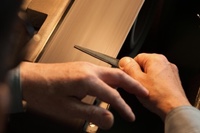Column
“Japanese Hairdressing Scissors vs. Overseas Scissors: Key Differences”
Japanese hairdressing scissors, used by beauty professionals in Japan, have several key differences from scissors made abroad or by non-Japanese craftsmen:
- Blade Material and Hardness:
- Japanese scissors are crafted from high-quality steel materials and are typically hardened to ensure long-lasting sharpness. This ensures that the scissors maintain their cutting edge over an extended period.
- Blade Shape:
- Japanese scissors often feature unique blade shapes designed specifically for hair cutting. For instance, scissors used for precision cutting or texturizing may have distinct blade designs that are well-suited for fine work.
- Sharpness of the Blades:
- Japanese scissors are known for their exceptional sharpness, allowing for precise cutting. Traditional Japanese blade-making techniques ensure that the edges of the scissors are maintained razor-sharp, enabling hairstylists to cut hair accurately.
- Handcrafted by Artisans:
- Many Japanese scissors are handmade by skilled artisans. This meticulous craftsmanship ensures stringent quality control and attention to detail. The expertise of these artisans optimizes the sharpness and performance of each pair of scissors.
- Maintenance:
- Japanese hairstylists regularly maintain their scissors to ensure their longevity and sharpness. This maintenance may involve blade sharpening and oiling, among other procedures.
On the other hand, scissors made abroad can also be of high quality and serve as excellent tools for hairstylists. However, Japanese scissors possess unique features backed by tradition and craftsmanship that make them particularly well-suited for fine and precise hair-cutting tasks. When choosing scissors, hairstylists should consider their specific needs and preferences.


